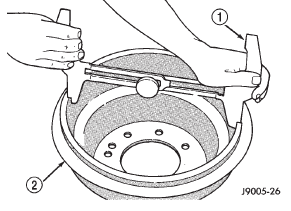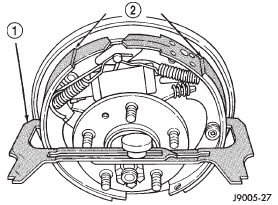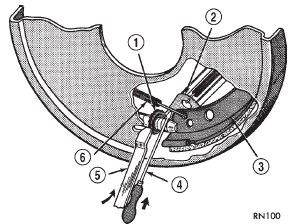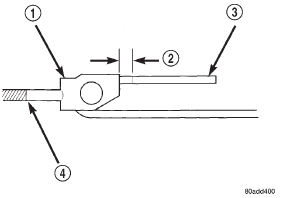Jeep Cherokee (XJ): Adjustments
(1) Press and hold brake pedal in applied position.
(2) Pull switch plunger all the way out to fully
extended position.
(3) Release brake pedal. Then pull pedal lightly
rearward. Pedal will set plunger to correct position
as pedal pushes plunger into switch body. Switch will
make ratcheting sound as it self adjusts.
CAUTION: Booster damage may occur if the pedal
pull exceeds 20 lbs.. The rear drum brakes are equipped with a self-adjusting
mechanism. Under normal circumstances, the
only time adjustment is required is when the shoes
are replaced, removed for access to other parts, or
when one or both drums are replaced.
Adjustment can be made with a standard brake
gauge or with adjusting tool. Adjustment is performed
with the complete brake assembly installed
on the backing plate. ADJUSTMENT WITH BRAKE GAUGE (1) Be sure parking brakes are fully released.
(2) Raise rear of vehicle and remove wheels and
brake drums.
(3) Verify that left and right automatic adjuster
levers and cables are properly connected.
(4) Insert brake gauge in drum. Expand gauge
until gauge inner legs contact drum braking surface.
Then lock gauge in position (Fig. 58).
1 - BRAKE GAUGE (5) Reverse gauge and install it on brake shoes.
Position gauge legs at shoe centers as shown (Fig.
59). If gauge does not fit (too loose/too tight), adjust
shoes.
1 - BRAKE GAUGE (6) Pull shoe adjuster lever away from adjuster
screw star wheel.
(7) Turn adjuster screw star wheel (by hand) to
expand or retract brake shoes. Continue adjustment
until gauge outside legs are light drag-fit on shoes.
(8) Install brake drums and wheels and lower
vehicle.
(9) Drive vehicle and make one forward stop followed
by one reverse stop. Repeat procedure 8-10
times to operate automatic adjusters and equalize
adjustment.
NOTE: Bring vehicle to complete standstill at each
stop. Incomplete, rolling stops will not activate
automatic adjusters. ADJUSTMENT WITH ADJUSTING TOOL (1) Be sure parking brake lever is fully released.
(2) Raise vehicle so rear wheels can be rotated
freely.
(3) Remove plug from each access hole in brake
support plates.
(4) Loosen parking brake cable adjustment nut
until there is slack in front cable.
(5) Insert adjusting tool through support plate
access hole and engage tool in teeth of adjusting
screw star wheel (Fig. 60).
(6) Rotate adjuster screw star wheel (move tool
handle upward) until slight drag can be felt when
wheel is rotated.
1 - STAR WHEEL (7) Push and hold adjuster lever away from star
wheel with thin screwdriver.
(8) Back off adjuster screw star wheel until brake
drag is eliminated.
(9) Repeat adjustment at opposite wheel. Be sure
adjustment is equal at both wheels.
(10) Install support plate access hole plugs.
(11) Adjust parking brake cable and lower vehicle.
(12) Drive vehicle and make one forward stop followed
by one reverse stop. Repeat procedure 8-10
times to operate automatic adjusters and equalize
adjustment.
NOTE: Bring vehicle to complete standstill at each
stop. Incomplete, rolling stops will not activate
automatic adjusters. NOTE: Parking brake adjustment is only necessary
when the tensioner, or a cable has been replaced or
disconnected. ADJUSTMENT (1) Raise vehicle.
(2) Back off tensioner adjusting nut to create slack
in cables.
(3) Remove rear wheel/tire assemblies and remove
brake drums.
(4) Check rear brake shoe adjustment with standard
brake gauge. CAUTION: Excessive shoe-to-drum clearance, or
worn brake components will result in faulty parking
brake adjustment and operation. (5) Verify that parking brake cables operate freely
and are not binding, or seized. Replace faulty cables,
before proceeding.
(6) Reinstall brake drums and wheel/tire assemblies
after brake shoe adjustment is complete.
(7) Lower vehicle enough for access to parking
brake lever. Then fully apply parking brakes. Leave
brakes applied until adjustment is complete.
(8) Raise vehicle and mark tensioner rod 6.5 mm
(1/4 in.) from tensioner bracket (Fig. 61).
(9) Tighten adjusting nut at equalizer until mark
on tensioner rod moves into alignment with tensioner
bracket.
(10) Lower vehicle until rear wheels are 15-20 cm
(6-8 in.) off shop floor.
(11) Release parking brake lever and verify that
rear wheels rotate freely without drag.
(12) Lower vehicle.
NOTE: Do not loosen/tighten equalizer adjusting
nut for any reason after completing adjustment.
1 - TENSIONER BRACKETBrake lamp switch
Rear drum brake

Fig. 58 Adjusting Gauge On Drum
2 - BRAKE DRUM
Fig. 59 Adjusting Gauge On Brake Shoes
2 - BRAKE SHOES
Fig. 60 Brake Adjustment
2 - LEVER
3 - BRAKE SHOE WEB
4 - SCREWDRIVER
5 - ADJUSTING TOOL
6 - ADJUSTER SPRINGParking brake cable tensioner

Fig. 61 Tensioner Rod Measurement
2 - 6.5 mm (1/4 in.)
3 - TENSIONER ROD
4 - ROD TO EQUALIZER
Other materials:
Circuit actuation test mode. Diagnostic trouble codes. Diagnostic trouble code descriptions
Circuit actuation test mode
OPERATION
The Circuit Actuation Test Mode checks for proper
operation of output circuits or devices the Powertrain
Control Module (PCM) may not internally recognize.
The PCM attempts to activate these outputs and
allow an observer to verify proper operation. Most o ...


